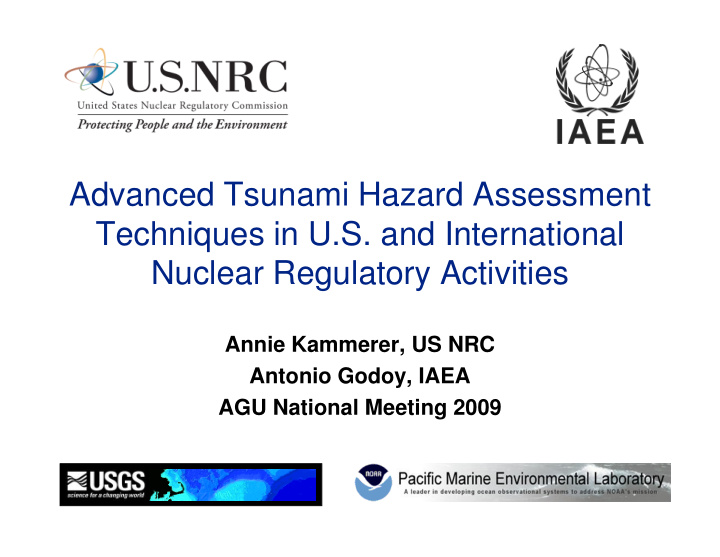



Advanced Tsunami Hazard Assessment Techniques in U.S. and International Nuclear Regulatory Activities Nuclear Regulatory Activities Annie Kammerer, US NRC Antonio Godoy, IAEA AGU National Meeting 2009
Motivation for Tsunami Activities • Indian Ocean Tsunami • Indian Ocean Tsunami • US Nuclear Renaissance • Large number of nuclear “newcomer” nations among IAEA Member States
US Regulatory History • Regulatory Guide 1.59 (1977) – Identifies tsunami hazard, but no details • NOAA PMEL and PNNL reports support updated Standard Review Plan (3/2007) • Office of Research initiates research program to develop sources and techniques
US Regulatory History • NRC, USGS, and NOAA initiate research work in source characterization and work in source characterization and modeling (2006-2007) • USGS (with A&M) starts leading assistance to NRC with 2 license reviews (2008) – South Texas Project (Gulf) – Calvert Cliffs (Atlantic)
US Regulatory History • NRC initiates development for new regulatory guide on tsunami (2009) regulatory guide on tsunami (2009) – Current allow hierarchical approach – Incorporation of climate change – Need guidance on modeling tool characteristics – Need guidance on PTHA
Hydrologic Hazard Analysis 1 Descriptive Hydrology * Safety Analysis Report 2 Historic Flood 1. Introduction 2. Site Characteristics 3 PMP/PMF 2.1 Geography 4 Dam Failure 2.2 Site Vicinity REG. RULE 5 Surge & Seiche 2.3 Meteorology 10 CFR 2.4 Hydrology RGs 6 Tsunami Hazards 2.5 Seismology 2.5 Seismology SRP 7 Ice Effects NUREGs 8 Cooling System 3. Plant Systems Reports : 9 Flood Protection : 10 Channel Division 19. Emergency Plan 11 Low Water * Environmental Report 12 Ground Water 13 Effluent Transport 14 Emergency Operation 6
US NRC Research Program • Phase 1: Identification and preliminary analysis of existing data for source characterization and approach characterization and approach • Phase 2: Additional analysis of sources, data collection and global modeling • Phase 3: Probabilistic hazard analyses and modeling technical basis documents • Phase 4: Regulatory Guide on Tsunami
Source Characterization • Publically available USGS report in use by industry and NRC • Updated 2008 • Updated 2008 • ML082960196
International Activities • Update of IAEA Safety Guide 417, “Meteorological and Hydrological Hazards in “Meteorological and Hydrological Hazards in Site Evaluation for Nuclear Installations” – Expands tsunami discussion – Includes treatment of climate change • Series of international workshops held – India 2005, Italy 2006, India 2010
International Activities • Extra-Budgetary Project to develop international capabilities for tsunami international capabilities for tsunami hazard assessment (2008-2010) – NRC, NOAA and USGS participation • New IAEA International Seismic Safety Center formed (7/2009) and now leads tsunami work
IAEA EBP • Goal to improve international practice in tsunami hazard assessment • Sponsored by Japan (JNES) and US • Sponsored by Japan (JNES) and US – Participants from Korea, India, Pakistan, Turkey, Egypt, Indonesia, Japan & US (NRC, NOAA & USGS) • NOAA provided training on ComMIT system – ComMIT is an internet-enabled interface to the community tsunami model developed by the NOAA Center for Tsunami Research (NCTR)
US NRC ComMIT Training • NOAA ComMIT training at NRC training at NRC • Open to IAEA participants as IAEA ISSC activity • Interfaces with tsunami warning
IAEA and NRC Tsunami Response • NOAA, NRC and IAEA collaborative work to implement existing warning tools into to implement existing warning tools into incident response • Development of critical use software for analysis of impact (similar to ShakeCAST) • Integration with ComMIT software in the US and Internationally
THANK YOU
Recommend
More recommend